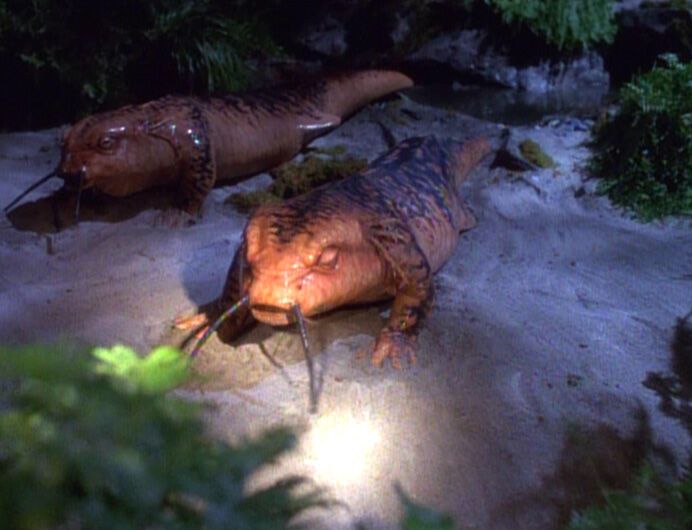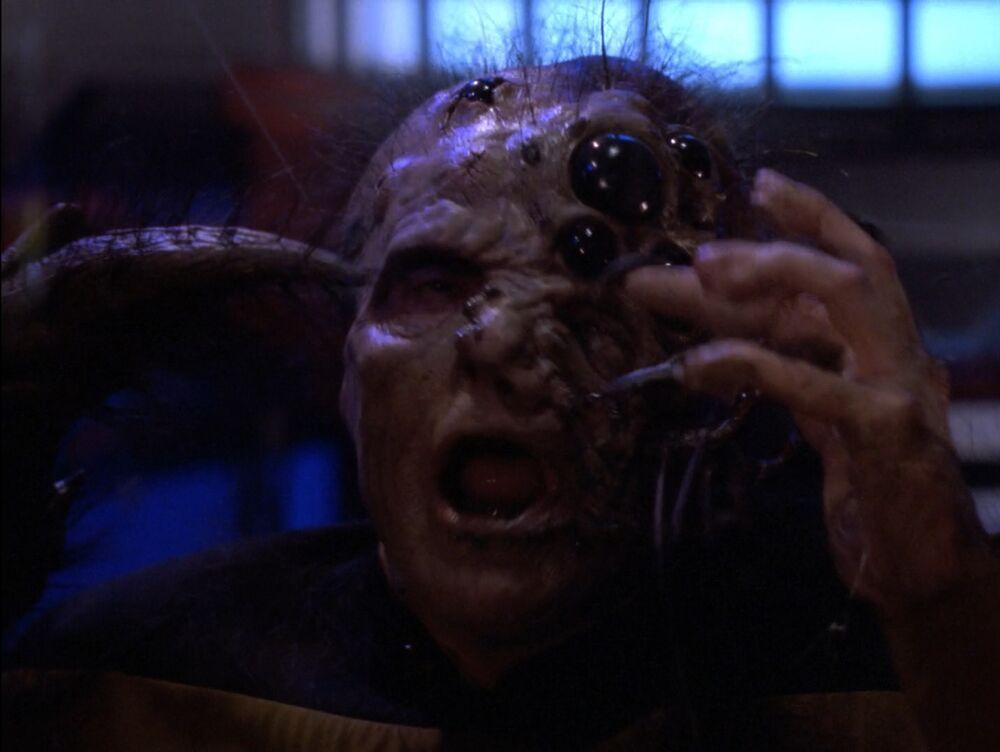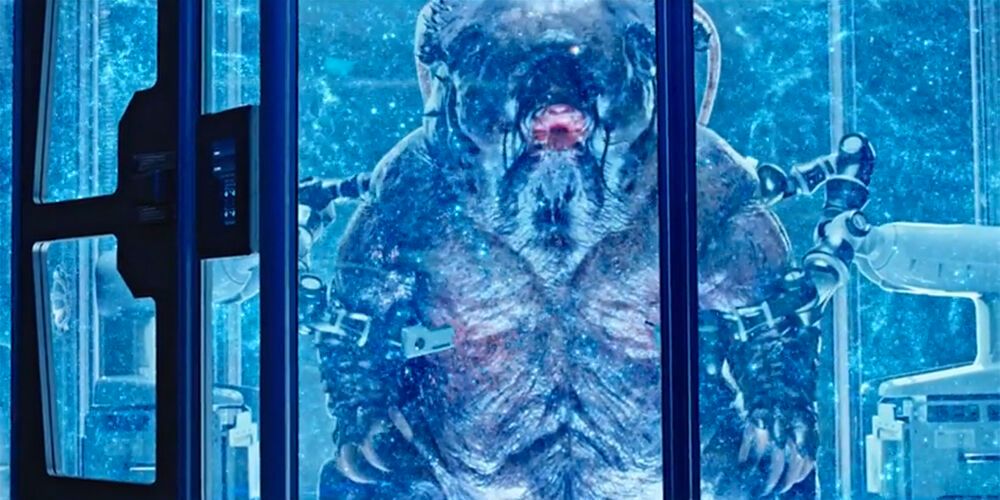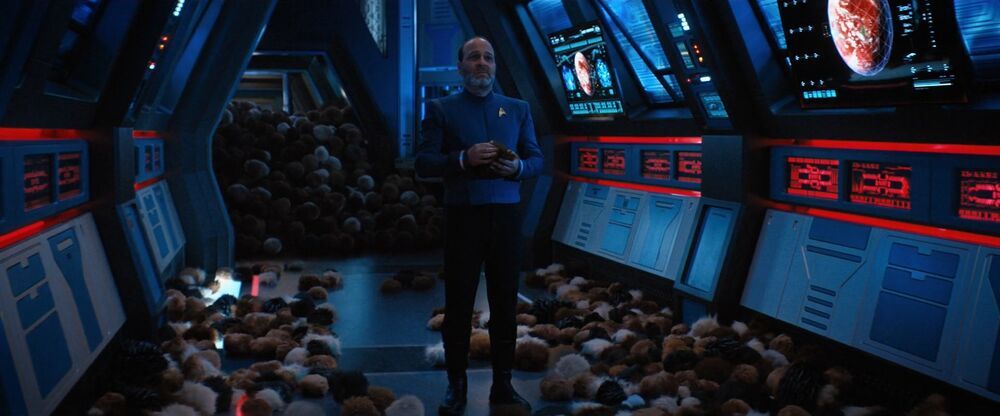Five times Star Trek biology plots went off the rails

In a now infamous scene from a 25 year-old Star Trek:Voyager episode, Commander Chakotay and Lieutenant Tuvok beam down to a remote swamp world in search of Captain Janeway and Lieutenant Paris. Instead, the officers encounter two oversized salamanders that bear traces of the missing crew members' DNA, along with some giant salamander babies. After Chakotay stuns the adult swamp creatures and brings them back to the ship, the Doctor reverts them back to their human selves using an anti-proton treatment. Mercifully, Paris and Janeway's amphibious offspring are left behind in the morass.
Thus concludes what is widely considered one of the worst Star Trek episodes of all time. “Threshold,” which most Trek devotees have worked hard to forget (you can thank me later for reminding you), raises a host of uncomfortable questions that the show never bothered to answer. What happens to the captain's swamp spawn after the crew abandons them? Does Paris ever tell chief engineer B’Elanna, who later becomes his wife, about his amphibious offspring? How is it possible that no one ever brings up this god-awful incident ever again?
Perhaps most importantly, who the hell decided that two humans mutating into horny salamanders through an accelerated form of evolution made any sense at all as a plot point?

I’m not sure, but I know this: It’s far from an isolated incident. Star Trek isn’t known for sticking to the laws of physics, but I would argue that it takes even more extreme liberties with the biological sciences. Sometimes, this can be chalked up to scientsts' limited understanding of a subject, like genetic engineering, at the time the series was airing. In other cases the writers appear to have lifted a page from a biology textbook, soaked it in LSD, and chopped it up into confetti.
In no particular order, here are a few ways biology has been mutated beyond recognition on the Final Frontier.
That time the Enterprise crew ‘de-evolved’
Mysterious phenomena that cause the crew to behave strangely are part and parcel of life on a galaxy-class starship, but strange doesn't really begin to describe what happens in The Next Generation’s “Genesis” after Dr. Crusher treats Lieutenant Barclay's Urodelan flu by activating a dormant immunity gene within his cells. The treatment goes horribly wrong, and dormant genes, which the episode refers to as “introns,” start waking up all over Barclay’s genome, causing him to “de-evolve” into an arachnid. To make matters worse, Crusher’s treatment is highly contagious. Soon, all of the Enterprise’s humanoid crew members are being reprogrammed at the genetic level, mutating into a variety of “proto-human” creatures including an amphibian (Counselor Troi) a lemur-like primate (Captain Picard), and a venomous werewolf (Lieutenant Worf).
Fully untangling the Frankenstenian knot of bio-babble within “Genesis” would be impossible, but there are a few important things to clear up here. First, and perhaps most obviously, “de-evolution” isn’t a thing — a process of change over time, evolution doesn't run in a consistently predictable direction. And it doesn’t operate on the level of individuals, but at the population level through the slow accumulation of DNA mutations that are subsequently driven through a species by natural selection and genetic drift. If an individual suddenly accumulated a lot of random mutations in their genes, they would die.

Even if individuals could change over time by accumulating DNA mutations in an evolution-like process, that’s not the same thing as turning on dormant genes, much less “dormant introns.” Introns are snippets of non-coding DNA within existing genes, not genes that no longer function. Those are called pseudogenes.
“If they said ‘pseudogenes’ the whole thing would have made a lot more sense,” said Duke University evolutionary geneticist Mohamed Noor, the author of Live Long and Evolve: What Star Trek Can Teach Us about Evolution, Genetics, and Life on Other Worlds. “It still doesn’t work, but it makes a lot more sense.”
At the end of the episode, Captain Picard and Commander Data save the day by developing a retroviral treatment that makes the crews' hyperactive introns go dormant again. Unfortunately, this is just as nonsensical as the intron virus that wreaks Darwinian havoc aboard NCC-1701D in the first place.
Retroviral therapies are a real thing, but “a retrovirus would not be able to affect DNA expression throughout a person’s genome,” Ila Nimgaonkar, who holds a PhD in virology from Princeton University, told The Science of Fiction. Nimgaonkar explains that retroviruses — RNA viruses that insert a DNA copy of their genome into a host cell — can only infect actively dividing cells. This makes them useful for treating certain rare blood disorders, like severe combined immunodeficiency, but less so for reprogramming every cell in a person’s body.
“The retrovirus simply wouldn’t get into the vast majority of cells in the body that are non-dividing,” Nimgaonkar said.
In other words, if the Enterprise crew were somehow transformed into amphibians and arachnids, they'd probably be stuck that way.
Janeway fights a ‘macrovirus’
It’s not often that a Starfleet captain is forced to skulk through her ship hunting alien invaders Ellen Ripley-style, but that’s the situation Captain Janeway finds herself in after returning from an away mission to discover the crew has vanished and big, buzzing beasties have taken over Voyager. But the tentacled flying creatures featured in "Macrocosm" aren't your typical alien invaders — they’re viruses capable of attaining exceptional sizes by, er, absorbing growth hormones into their protein structure, or something. With most of the crew out of action, Janeway must lure a cluster of these dog-sized macrobes into a trap while the Doctor develops an antiviral treatment.
While the growth hormone explanation is dubious at best, the real head-scratcher here is how macroviruses get so many orders of magnitude larger than any virus humans have previously encountered. Viruses do vary in size quite a bit, but they are typically measured in nanometers, or millionths of a millimeter.
Ultimately, a virus’s size is constrained by the size of its host cells, since viruses need hosts to replicate. Beyond that, Nimgaonkar explains that size is a tradeoff between efficient replication — smaller viruses use fewer resources and can multiply and spread more quickly — and a larger genome, which can give the virus additional tricks for infecting its host or evading the immune system.

Brandon Ogbunu, an assistant professor of ecology and evolutionary biology at Yale University, says that from a pure physics perspective, there are no real limits to how big viruses can get. In theory, he says, “one could build a very large virus.”
“The problem with a mega-sized virus is that they might make lousy parasites,” Ogbunu told The Science of Fiction. “They might trigger immune systems, they might have a difficult time entering host cells.”
Or they might simply be picked by a determined Starfleet captain with a plasma rifle.
Star Trek:Discovery’s space fungus superhighway
Look, I love tardigrades as much as the next person. The microscopic animals resembling bears with extra legs can survive all sorts of extreme conditions, including the vacuum of space, by entering a state of suspended animation or “cryptobiosis.” I’m also a huge fan of fungi and a proponent of the many technological applications for them, from bioremediation to futuristic building materials. I’ve enjoyed listening to crusading mycologist Paul Stamets speak about the wonders of the mycelial network, a vast interconnected web of fungal filaments that cycles nutrients, shares information, and shapes entire ecosystems.
But Star Trek Discovery’s intergalactic mycelial network that polar bear-sized space tardigrades use to traverse the yawning distances of the universe? Someone in the writers’ room ate some special mushrooms while they were coming up with that one.
I don’t have much to say about the space fungal superhighway Discovery’s spore drive uses to jump across the galaxy, other than whoever invented it was obviously a Stamets fan, too (Discovery’s astromycologist is literally Lieutenant Paul Stamets). It looks hella cool, but isn’t particularly scientific. The giant space tardigrades, though, are a mixed bag.

“Cryptobiosis was featured in Discovery, so that element of science was spot on,” University of Washington astrobiologist Michael Wong, who hosts the science and Star Trek podcast Strange New Worlds, told The Science of Fiction.
But, Wong says, being able to survive in outer space by pausing your metabolism is different from living and reproducing in a frigid, airless vacuum, as Discovery’s space tardigrades appear to be capable of. There’s also the fact that tiny tardigrades have a much higher surface area to volume ratio than their supersized galactic cousins, making it easier for them to enter (or come out of) suspended animation by dehydrating or rehydrating their bodies.
Clearly, there are still some open scientific questions about jumbo tardigrade biology. Maybe Lt. Stamets will find some answers as he studies the effects of infusing his own cells with tardigrade DNA. That’s actually not so different from how 21st century scientists are learning about these amazing creatures.
The real trouble with Tribbles…
Is that they don’t make a whole lot of sense. First introduced in a knockout episode of Star Trek’s original series, these fast-breeding, potato-sized furballs make a number of appearances throughout the franchise, including in Star Trek’s original animated series, Deep Space 9, and again in Star Trek:Discovery where we learn more about their unnatural origins.
The original Trouble With Tribbles episode was inspired by the epidemic of rabbits that swept across Australia after their introduction by European colonists in the 19th century. The episode does a good job introducing the basic idea that invasive species can multiply like crazy in new environments where they lack predators and other biological constraints. Tribbles brought the concept of invasive species to a galactic scale, wreaking havoc on numerous planets and interplanetary shipments of quadrotriticale.
The problem with Tribbles isn’t that they are “born pregnant” as Doctor Bones notes, or that they can reproduce without a mate: Many organisms, including most flowering plants and some invertebrates, are capable of self-fertilization. “In principle something could be born pregnant if it’s self fertilizing,” Noor said, adding that self fertilization helps generate genetic variation, which could explain why Tribbles come in a variety of colors and sizes.

The much bigger problem is that Star Trek never explains how, exactly, Tribbles are capable of creating so much new Tribble mass so quickly. Noor points to a particularly baffling scene in the recent Short Trek episode “The Trouble With Edward,” where the furballs have multiplied to fill entire hallways aboard the USS Cabot mere hours after a laboratory breach let them loose.
“Even if they sucked all the air out of there and ate every bit of food [on the ship], I don’t think you could make that much mass,” Noor said.
Those salamander babies never should have been born.
Like “Genesis,” “Threshold” makes a big biological faux pas by projecting the idea of evolution onto individuals — in this case, Lieutenant Paris and Captain Janeway, who undergo “millions of years” of evolutionary change after crossing the transwarp barrier. While this Trek episode correctly ties evolution to the concept of DNA mutations, it ignores the fact that mutations occur randomly. If an individual were to accumulate millions of years worth of DNA mutations, they would most likely get a thousand forms of cancer, not sprout gills and tails. And there isn’t a chance in hell random genetic mutations would cause two individuals to change in exactly the same way, making them reproductively compatible.
“Deterministic evolution comes up a lot in Star Trek,” Noor said. “And in this case, not only can you predict it, it’s also repeatable. It happened with Tom Paris, and then from exactly the same circumstances, Janeway went through the same thing. Aside from some weird space time connection, I don’t see how that could happen.”
So, if you were as bothered as I was by Janeway and Paris’ unholy offspring, take comfort in the fact that science says the coupling never would have worked.